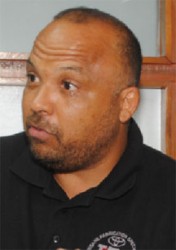Miles Williams has come a long way from flying twin-engine Islander aircraft for the Guyana Defence Force during the late 1980s; he serves as Chief Pilot and flies Lear Jets for a high-profile company in Naples, Florida.
Nonetheless, he retains a passionate interest in the local aviation industry, concerned that the growth of the sector keeps pace with the demands that will continue to be made of it by an economy that is inextricably bound up with parts of the country that are not easily accessible except by air.
Prior to migrating to the United States in 2000, Williams had served with the Guyana Defence Force Air Corps before flying with various local private aviation enterprises; his last local assignment being as Chief Pilot of Roraima Airways.

Williams’s observations about the shortcomings of the local aviation sector are direct and to the point. Our airstrips, particularly, are badly in need of major overhaul and some of our interior locations that have become hives of investment activity ought to benefit from other infrastructural upgrades that allow for an enhanced aviation culture.
He concedes that the financial and logistical implications of upgrading interior airstrips are considerable. There are, he says, the high costs including the transportation challenges associated with moving material and equipment to remote parts of the country, recalling that several years ago he had been involved in flying cement from Konawaruk to Kaieteur to upgrade the airstrip there. Having conceded that it’s costly, Williams says that there can be no half measures if Guyana is to create a modern and efficient aviation sector.
In this regard, he is dubious of a policy of simply “patching” rundown airstrips. “If they are going to be in use over several years we need to access the resources, including the skills to build them properly,” he says.
More than that, he believes the administration of the sector might be in need of a measure of overhaul to minimise certain risks and cites the recent incident in which a foreign-owned aircraft leased foreign-owned aircraft leased to conduct aerial survey work crashed into a house at Sparendaam killing its pilot and passenger. Based on the revelations that have arisen from the mishap he wonders aloud about the responsibility of the national aviation authority to make a definitive determination about whether or not aircraft are licensed to fly in this part of the world.
Worse, he says, the local Civil Aviation Authority – being a decidedly interested party – ought not to have been allowed to investigate the accident. Here, Williams speaks with the authority of Chief Pilot of Jet 1 Charter Inc, a Naples, Florida-based company that manages privately-owned corporate jets.
His job has landed him some pretty interesting assignments like flying the Governor of Florida.
At the same time, he has become versed in the multi-faceted discipline of corporate aviation. Jet 1 operates on what is known in US aviation as a 135 Certificate which means that it provides on-demand charters.
The responsibilities associated with complying with the requirements of national aviation laws are demanding. As Chief Pilot, Williams is Jet 1’s ‘go to’ man as far as satisfying the requirements of the US Federal Aviation Authority (FAA) is concerned.
As regards the recent local aircraft accident, he points out that the local Civil Aviation Authority is the equivalent of the FAA and the likelihood of it being an interested party ought to have disqualified it from having anything to do with the investigation. “In the United States that would have been the responsibility of the National Transport Safety Board,” Williams says, adding that there ought to be an equivalent body here.
For all its deficiencies, Williams says the growth of the local aviation sector is reflected most in the “splendid job” which the private operators have been doing. He notes, first, the creation of the Ogle International Airport through the collective efforts of the local private aircraft companies, a development which he says adds value to the aviation sector.
Equally noteworthy, he says, is the manner in which these privately-run companies have been able to sustain service to interior locations, defying conditions, which, in many instances, makes the job challenging. Still, he believes it is imperative to create an aviation sector that sustains the critical social and economic linkages between coastal Guyana and the various other regions of the country.
Twenty-six years after graduating from the Flight Safety Academy in Florida and returning home to serve, first, the military then the private sector in the aviation sector, Williams remains attached to Guyana and more particularly to local aviation.
He talks about the need to accelerate the training of local pilots and about his own desire to return to Guyana, “perhaps to contribute in an aviation consultancy capacity,” focusing on “search and rescue and accident investigation” issues.





